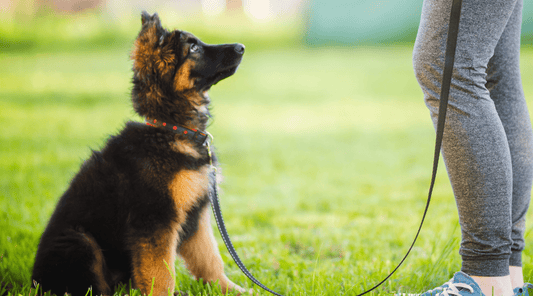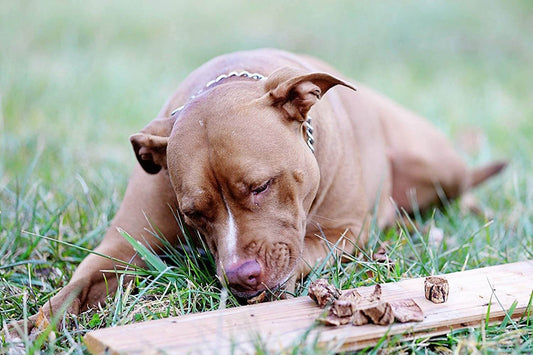
Cow Knuckle Bones for Dogs: A Royal Dog Treat for My Pups
Dawn Miller Nov 20, 20245 Minute ReadLast Saturday, I was at our town's annual "Be Well Event" at the old fairgrounds, where we celebrate the growing community of health and wellness-focused businesses, clubs, organizations, and activities. As a dog-loving community, many of my neighbors had brought their pups, as vendors handed out dog treats as we browsed booths, supporting local businesses, sniffing new pet products, and engaging in health-focused conversations like how I keep my dogs' teeth so clean, coats shiny, and energy levels rivaling those of much younger K9s.
Of course, cow knuckle bones for dogs came up in the discussion.
What Are Cow Knuckle Bones?
Knuckle bone is a common term for the joint areas of cattle legs. While not technically "knuckles" like you and I have, they are called this because, from the outside, these "knobs" appear a lot like human knuckles.
Types of Beef Knuckles for Dogs
You find the Crown Knuckle at the bottom of the cow's tibia in the cow's mid-back legs. It's called the tarsal joint, as it connects the tibia to the cow's metatarsals, so it would be most similar to our ankles. It's known as the biggest and also called a Royal Knuckle. Other joints, such as the stifle joint at the base of a cow's femur (akin to a human knee joint) can be turned into regular knuckles, which are a little smaller.
Why Cow Knuckles Make Great Dog Bones
They are larger around than the typical beef bone—and certainly a lot bigger than the knuckles on my hand. Cow knuckles have to support a lot of weight while also moving, making them a very durable and compact bony structure.
Their size and durability make them perfect for bigger chewers with oversized appetites—although they may be too small for some very large breeds, like a mastiff or Great Dane. They need something even bigger. You could Get a Goliath Bone.
Unlike traditional marrow bones, cow knuckle bones have additional cartilage and connective tissue, which are natural sources of glucosamine and chondroitin – excellent for supporting joint health in dogs.
Quick Rundown of the Benefits
- High in Collagen - Supports skin, coat, and joint health. I go into more detail about nutrition in this article you can check out next: Not Like Other Treats
- Rich in Minerals - Provides calcium, magnesium, and phosphorus.
- Packed with Flavor - Thanks to the natural cartilage, soft tissue, and sweet, buttery beef marrow.
- Mental Stimulation - Entertains dogs and their humans alike, which can reduce destructive behavior.
- Powerful Teeth-Cleaning Action - The unique shape gives dogs lots of crevices to scrape their teeth against, cleaning them.
- Ideal for Large and Medium Dogs - The compact, almost spherical shape makes them safe for most large dogs who can't swallow or crush it. At the same time, its knobs and crevices allow medium-sized dogs to get their jaw up around it to maximize the teeth cleaning and jaw-strengthening benefits.
Are Knuckle Bones Safe for Dogs?
If you have an aggressive chewer like my lab mix, Bruno, beef knuckle dog bones are some of the safest bones you can get. The compact shape makes it very difficult for a dog to break the bone. When prepared to the right density, they don't shatter or break teeth.
That said, there are some important guidelines to follow to maximize safety.
- Choose the Right Size - Always pick a bone size that’s appropriate for your dog. Larger dogs will handle big knuckle bones easily, but smaller dogs might need a smaller, more manageable piece. Either way, it's always better to give a small dog a too big bone than the other way around. The first concern is whether or not your dog can swallow the bone. Beware the blockage.
- Monitor Chewing - Supervision is key to avoid choking or biting off large chunks that could become lodged.
- Don't Allow Free Range Chew Time - The longer a dog chews on a bone, the more likely they are to apply enough pressure to break it or, worse, break a tooth. A safe amount of chew time is 15-20 minutes 2-3 times a week while you're home able to intervene. This aligns with the American Kennel Club's recommendation that treats be no more than 10% of a dog's diet.
- Avoid Raw Bones - Raw bones have a lot of nutrition—no doubt. But they are problematic because of the pathogens. The American Veterinary Medical Association recommends against raw food for dogs and cats.
And finally, buy from a dog bone vendor you trust. Bones need to come from healthy cows, preferably beef cattle, since dairy cows have weaker bones. They should be prepared correctly to reduce breakage.
My dogs and I trust K9 Connoisseur to get it right.
What Type of Bones Are Good for Dogs?
Knuckle bones deliver many advantages. But they're not the only best dog bone. Thick-walled beef marrow bones from grass-fed cattle born and raised in the USA are best.
All-beef, single-ingredient marrow-filled dog bones are packed with protein and healthy fats dogs need to stay healthy and active.
Since different size dogs benefit from different bones, here are some more to consider:
For small dogs, try beef kneecaps. The flat shape makes it easier for even the tiniest of pups to enjoy the meaty goodness while cleaning their teeth.
For medium-sized dogs, check out these meaty beef ribs. These single-ingredient dog bones are prepared to maximize safety and nutrition.
For big dogs besides knuckle bones, I'd recommend Champs Meaty Mammoth Bones. They're great for aggressive chewers.
And when the bones are emptied of that nutrient-dense marrow, consider refilling them with treats dogs love to make that dog bone last even longer. Peanut butter is one of Bruno's favorites. I share many other recipe ideas in this free dog bone refill guide.
Best Practices for Beef Knuckles for Dogs
While cow knuckle bones for dogs can be amazing for dogs' mental, physical, and dental health, it’s essential to introduce them carefully:
- Start Slowly - Especially if your dog hasn’t had bones before, begin with short chew sessions. Watch how they react. Most dogs will quickly take to a bone.
- Freeze Between Uses - Freeze it between chew sessions to keep it fresh and safe. It takes several 15-20 minute gnaw sessions to finish the marrow, often weeks or months. So, keep the bone preserved during that time. Over that period, refrigeration is not enough.
- Monitor for Wear and Tear - Discard any bone that starts to splinter or break down too much to prevent small pieces from being swallowed.
- Buy in Bulk - Once you find the best beef bones for your dog, go ahead and save with bulk discounts and subscriptions. The dog bones should be good for up to two years. That's plenty of time to get the benefits of several bones.
Why I Choose Knuckle Bones
Watching Bruno working at that beef knuckle, it's clear he's met his match as an aggressive chewer. For me, knuckle bones hit the sweet spot of natural, nutritious, and safe.
Available On:





